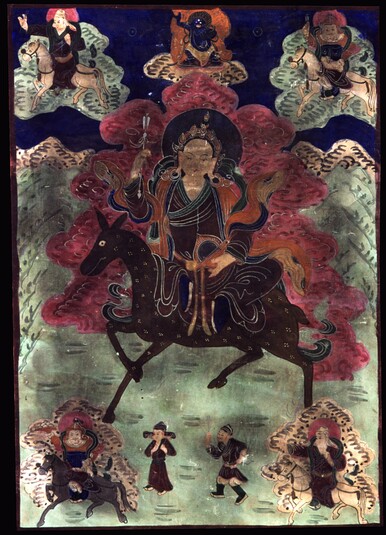
Item: Five Foremost Deities - Mo Lha
| Origin Location | Tibet |
|---|---|
| Date Range | 1800 - 1899 |
| Lineages | Nyingma |
| Size | 38.10x27.94cm (15x11in) |
| Material | Ground Mineral Pigment on Cotton |
| Collection | Erie Art Museum |
Classification: Deity
Appearance: Peaceful
Gender: Female
The Five Foremost Deities of the Individual (Tibetan: go wa'i lha nga).
"The Female Deity (mo lha) is beautiful and attractive wearing feminine silk clothing, with a body white in colour, one face and two hands. The right holds an arrow with silk streamers and the left a mirror. Wearing a blue cloak, a jeweled diadem and adorned with various ornaments; riding a hind, emanating forth female, maternal aunt and maternal uncle male deities, dressed the same and middle aged. Further emanating vulture shanlon figures and gathering together female deities, medicine ladies and numerous youthful stags.
The Life Deity (srog lha) is in the aspect of a white middle-aged male wearing armor and a helmet, holding a spear with silk streamers and a lasso; riding a swift black horse, emanating forth many white men and horses. The male deities are wearing silks and adorned with jewel ornaments.
The Male Deity (po lha) has a body white in colour, youthful, with flowing silks, holding a bucket filled with precious gems, wearing a blue cloak and adorned with jewels and a silk turban; riding a superior white horse. Emanating forth men, full grown brothers, paternal ancestor deities and the thirty deities of fate; wearing silk clothing and adorned with jewels.
The Regional Deity (yul lha) is white, holding an arrow and bow, wearing armor and a helmet; riding a superior white horse. Emanating forth religious brothers, masters of the land, many white yaks and flocks of sheep, fortress deities, of houses, etc., of marvelous places of protection.
The Enemy Deity (dra lha) is holding a spear with silk streamers and a lasso, the head bound with silk, wearing an excellent cloak of white silk and jewel ornaments; riding a swift white horse. Emanating forth spiritual friends and men armored with virtue, and many birds, wolves and wild yaks." (From the text: 'go ba'i lha lnga'i gsol mchod phan bde'i 'dod 'jo by Tukwan Lobzang Chokyi Nyima, 1737-1802).
Bibliographic record. Tibetan text source.
At the top center is the wrathful bodhisattva Vajrapani, blue, holding a vajra and lasso.
Other known paintings of the same subject:
The Essen Collection. Die Gotter des Himalaya (vol.2). Prestel-Verlag, Munchen, 1989. p.204, II-425.
The Guimet Museum. Les Peintures Du Bouddhisme Tibetain. Musee National Des Arts Asiatiques - Guimet, 1995. p.474, #400, (MG 23081) Vie de Ge-sar de gLing.
The Jucker Collection. Tibetan Painting. Hugo E. Kreijger. Shambhala, Boston: 2001. p.126-127, see detail bottom center.
The Rubin Foundation - painting 435
The Rubin Personal Collection - painting 315
Tibetan Painted Scrolls. Guiseppi Tucci. Rome: La Libreria Della Stato Roma, 1949. p.53, (vol.3).
Jeff Watt 8-2002
Collection of Erie Art Museum
Buddhist Protectors, Worldly Deities (Lokapala)
Buddhist Protectors: Worldly (Nyingma)
Buddhist Protectors: Worldly (Female)
Subject: Village Art Page
Tibetan Deity: Five Personal/Foremost Gods Main Page
